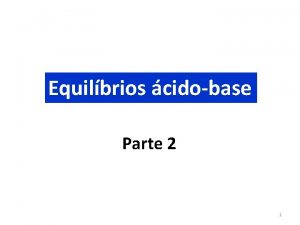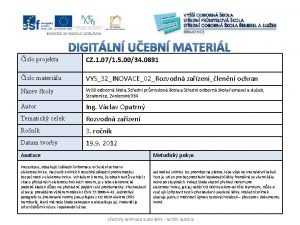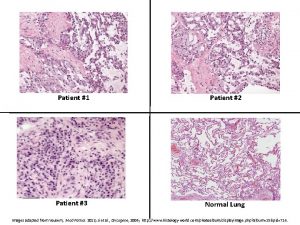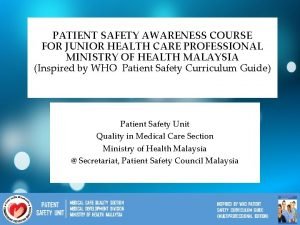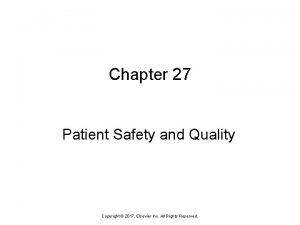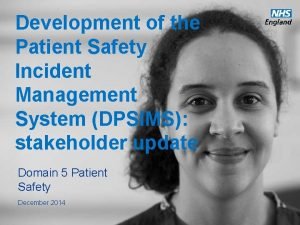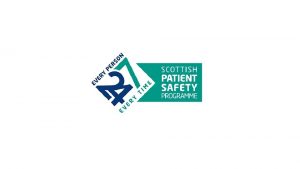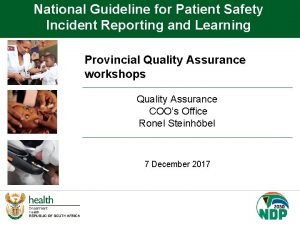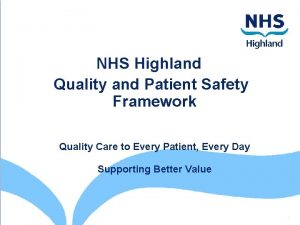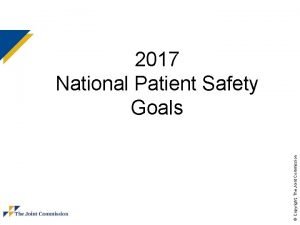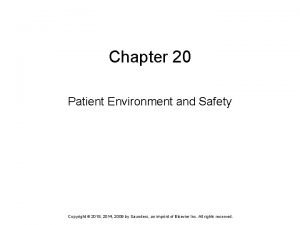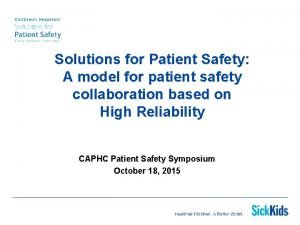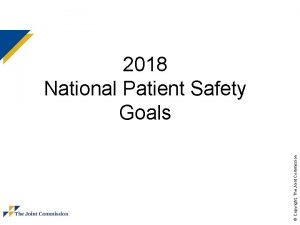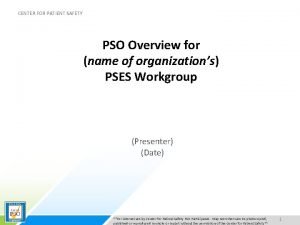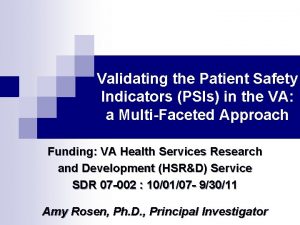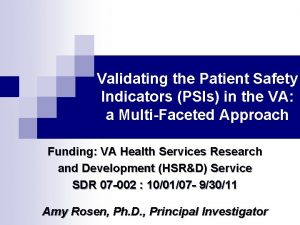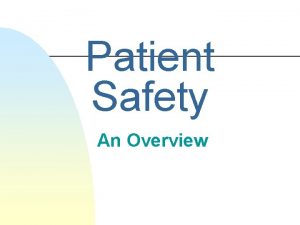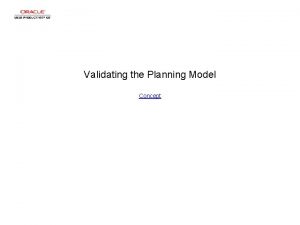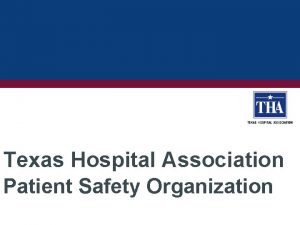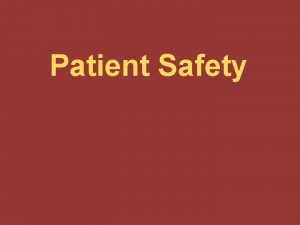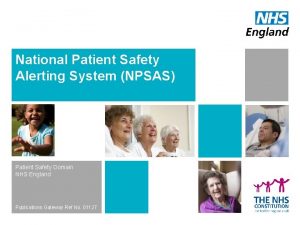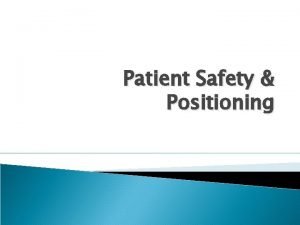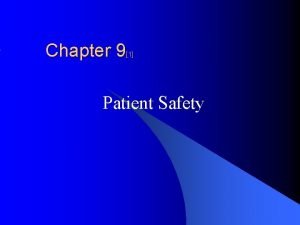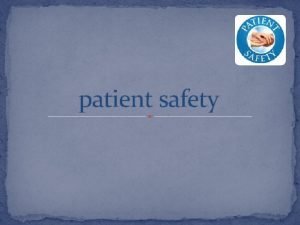Validating the Patient Safety Indicators PSIs in the






















- Slides: 22

Validating the Patient Safety Indicators (PSIs) in the VA: a Multi-Faceted Approach Funding: VA Health Services Research and Development (HSR&D) Service (SDR 07 -002) 10/01/07 - 9/30/11 Amy Rosen, Ph. D. , Principal Investigator William Weeks, M. D. , M. B. A. , co-Principal Investigator

Project Team n Collaboration between VA’s HSR&D Service, the National Center for Patient Safety (NCPS), and AHRQ (QI team and individual investigators) n VA and non-VA clinicians, surgical experts, nurse abstractors n National steering committee: ¨ Representatives from VA Office of Quality Performance, NCPS ¨ Nursing Services, Surgery, Patient Care Services ¨ Selected members of the AHRQ QI team ¨ Selected Patient Safety/QI Managers and other potential end-users 9/28/2007 Rosen Presentation at AHRQ 2

Project Development n Outgrowth of previous VA HSR&D grant to evaluate the PSIs using VA administrative data (2001 -2004) ¨ Rivard P, et al. Applying Patient Safety Indicators (PSIs) Across Healthcare Systems: Achieving Data Comparability. In Advances in Patient Safety: From Research to Implementation, Agency for Healthcare Research and Quality and Department of Defense; 2005. ¨ Rivard P, et al. Creating learning organizations: Are Patient Safety Indicators ( PSIs) a step in the right direction? Health Services Research 2006: 41(4, Part II): 1633 -1653. ¨ Rosen AK, et al. Evaluating the Patient Safety Indicators (PSIs): How well do they perform on VA data? Medical Care 2005: 43(9): 873 -884. ¨ Rosen AK, et al. Tracking Rates of Patient Safety Indicators over Time: Lessons from the VA. Medical Care 2006: 44(9): 850 -861. ¨ Rivard P, et al. Using Patient Safety Indicators to Estimate the Impact of Potential Adverse Events on Outcomes. In press, Medical Care Research and Review, 2007. ¨ Romano P, et al. Validating Selected Patient Safety Indicators: Can Administrative Data be Used to Assess Safety Performance? Submitted, Health Services Research, 2007. ¨ Rivard P, et al. Is there an Association between AHRQ’s PSIs and Hospital Teaching Status? Submitted to Advances in Patient Safety. Agency for Healthcare Research and Quality, 2007. ¨ Shimada S, et al. Racial Disparities in Patient Safety Indicator (PSI) Rates in the Veterans Health Administration. Submitted to Advances in Patient Safety. Agency for Healthcare Research and Quality, 2007. 9/28/2007 Rosen Presentation at AHRQ 3

Project Development n n n Increasing interest within the VA and outside on ¨ Comparing hospitals nationally on safety performance ¨ Developing accurate hospital report cards ¨ Pay-for-performance Concerns among VA managers, researchers, policy makers ¨ PSIs may present inaccurate picture of individual hospital’s performance & unfair comparisons of VA hospitals vs. private sector hospitals ¨ PSIs are not validated measures!!!! HSR&D-funded meeting of key stakeholders, researchers, and AHRQ collaborators in October 2006 to develop and frame proposal to validate the PSIs 9/28/2007 Rosen Presentation at AHRQ 4

Overall Project Goal n Develop a validated and reliable set of patient safety measures that broadly reflect the interests of key VA stakeholders, but that are generalizable beyond the VA. n Specific Objectives: 1. Develop collaborations with key stakeholders to guide in PSI selection and validation 2. Investigate the criterion validity of the PSIs by review of the VA’s EMR 3. Identify explicit processes and structures of care associated with individual PSIs (assess attributional validity) 4. Revise and improve the PSIs using multiple data sources and settings of care 5. Assess the utility validity of the PSIs for QI and performance measurement 9/28/2007 Rosen Presentation at AHRQ 5

Objective 1: Develop Collaborations with Key Stakeholders Steering committee (stakeholders) duties: ¨ Meet ¨ Act regularly throughout the project as an oversight group ¨ Develop selection criteria to guide PSI selection and validation process ¨ Assess usefulness and relevance of specific PSIs for VA 9/28/2007 Rosen Presentation at AHRQ 6

Objective 2: Investigate the Criterion Validity of the PSIs Using the EMR n First Step: Identify False Positives ¨ Are cases flagged by the AHRQ PSIs present in the EMR? n Second Step: Identify False Negatives ¨ Are cases present in the EMR not flagged by the AHRQ PSIs? 9/28/2007 Rosen Presentation at AHRQ 7

Objective 2: First Step Identify False Positives Hospital Selection n Divide hospitals into major surgery vs. minor/no surgery hospitals n Apply PSI software to 2006 VA inpatient data n Use AHRQ PSI composite measure to rank 2 groups of hospitals on riskadjusted PSI rates n Within each group, select 3 hospitals with lowest and 3 hospitals with highest score n Stratify remaining hospitals into quartiles; randomly select 2 hospitals from each stratum for each group n N= 14 major surgery hospitals, 14 minor/no surgery hospitals 9/28/2007 Rosen Presentation at AHRQ 8

Objective 2: First Step Identify False Positives n 1, 680 flagged discharges to identify false positives (4 discharges flagged for each PSI at 28 hospitals; 112 flagged cases per PSI) n May use 2002 -2006 data for low-frequency PSIs to reach 112 n Modify AHRQ chart-abstraction forms for selected PSIs for VA n Obtain national access to EMRs through Vist. AWeb in VA n Pilot test abstraction tools and train nurse abstractors n Examine inter-rater reliability n Conduct chart abstraction using explicit criteria over a period of 18 months 9/28/2007 Rosen Presentation at AHRQ 9

Objective 2: Second Step Identify False Negatives a) Use an existing “gold standard” (e. g. , the VA National Surgical Quality Improvement Project (NSQIP) for 5 surgical PSIs) (about 100 cases). b) Identify subgroups of discharges that may be at high risk of specific PSIs. Screen EMRs of these patients using keyword searches. Each “hit” (keyword) will have chart reviewed for PSI. c) Use other VA databases to identify cases with PSIs and match with unflagged cases in discharge data (e. g. , VA Nursing Outcomes Database for decubitus ulcer) (about 100 cases). 9/28/2007 Rosen Presentation at AHRQ 10

Total Cases for Abstraction Based on 15 PSIs n 1, 680 flagged discharges to identify false positives (4 discharges flagged for each PSI at 28 hospitals) (112 flagged cases per PSI) n 1, 680 for matched controls n 100 re-abstracted cases to determine inter-rater reliability n 100 cases for false negatives (NSQIP) n 100 cases for false negatives (other databases) n 500 additional cases: false negatives, revise PSIs n Total # of charts for abstraction: 4, 160 9/28/2007 Rosen Presentation at AHRQ 11

Objective 3: Identify Processes and Structures of Care Associated with Individual PSIs n First Step: Is a specific PSI associated with explicit processes of care (e. g. , general processes of care and/or evidence-based patient safety practices)? n Second Step: Do high-performing facilities have higher rates on structures and processes of care than lower-performing facilities? 9/28/2007 Rosen Presentation at AHRQ 12

Objective 3: First Step Examine Association Between Explicit Processes of Care and Individual PSIs n Match 1, 680 flagged PSI cases with 1, 680 controls (unflagged cases matched on demographic and clinical characteristics) to determine whether flagged cases are more likely to experience “process failures” n Use propensity score methodology to perform matching; chi-square tests used to examine proportion of failure rates among cases and controls 9/28/2007 Rosen Presentation at AHRQ 13

Objective 3: Second Step Do high-performing facilities have higher rates on structures and processes of care than lowerperforming facilities? n EMR lacks information on structural characteristics of hospitals; documentation on processes of care may be incomplete n Conduct site visits at 6 facilities n ¨ Sites selected based on PSI composite score (2 highest, 2 lowest, 2 “average-scored”) ¨ Structured interviews performed with selected staff at each site to gather data on safety and quality Assess differences between sites on structures and processes using qualitative methods 9/28/2007 Rosen Presentation at AHRQ 14

Objective 4: Revise and Improve the PSIs a) Add additional data elements to inpatient data: n Present-on-admission (POA) diagnoses, do-not-resuscitate (DNR) codes, selected clinical, laboratory and pharmacy data elements b) Link inpatient data with outpatient/inpatient data 30/60 days preceding index hospitalization (obtain POA diagnoses) c) Link inpatient data with outpatient/inpatient data 30/60 days following index hospitalization to evaluate whether additional PSIs are detected d) Link VA and Medicare data to examine PSI readmission in private sector e) Use text query searches (Objective 2) to improve coding f) Modify PSI numerators and denominators on inclusion/exclusion criteria g) Recalculate false positives and negatives 9/28/2007 Rosen Presentation at AHRQ 15

Objective 4: Example of PSI Modification “Decubitus Ulcer” n Additional POA information from preceding inpatient/outpatient data or EMR: distinguish between ulcers acquired in-hospital vs. those that were POA. Eliminate cases with POA from denominator n Add patients with spinal cord injury and those admitted from longterm care facilities to the denominator: “high-risk” groups in the VA “Failure to Rescue” n Restrict denominator to surgical patients (NQF): difficult to distinguish POA conditions from complications among medical patients n Add DNR information from NSQIP or from EMR: if DNR found, eliminate case from denominator 9/28/2007 Rosen Presentation at AHRQ 16

Objective 5: Assess the Utility of the PSIs for QI and Performance Measurement n First step: Conduct focus groups with end-users to obtain baseline perceptions of PSI utility and information on barriers to/facilitators of implementation n Second step: Conduct Breakthrough Series (QI initiative) with selected hospitals to assess utility of PSIs for QI and performance measurement 9/28/2007 Rosen Presentation at AHRQ 17

Objective 5: First Step Assess Baseline Utility Validity n Develop and disseminate hospital-level PSI reports to six sites n Conduct focus groups with end-users to obtain baseline perceptions of PSI utility and information on barriers/facilitators of implementation n Redesign and disseminate hospital-level PSI reports based on feedback 9/28/2007 Rosen Presentation at AHRQ 18

Objective 5: Second Step Assess Utility Validity of PSIs for QI and Performance Measurement n Conduct modified Breakthrough Series (BTS) at 30 hospitals on selected surgical PSIs n Assess whether PSIs facilitate actions that lead to improvements in care (case-finding, root cause analyses) n After BTS, conduct focus groups: ¨ Examine how PSIs are used ¨ Assess whether PSIs led to QI and performance measurement ¨ Assess value and utility of hospital-level PSI reports 9/28/2007 Rosen Presentation at AHRQ 19

Overall Goal n Develop a validated and reliable set of patient safety measures that broadly reflect the interests of VA stakeholders, but that are generalizable beyond the VA. 9/28/2007 Rosen Presentation at AHRQ 20

Diagram of Study Objectives DEVELOP COLLABORATIONS WITH STAKEHOLDERS CRITERION VALIDITY Identification by: • Vist. AWeb • NSQIP • Text queries on VA databases Identify false negatives CONSTRUCT/ PREDICTIVE/ CRITERION VALIDITY UTILITY VALIDITY 9/28/2007 ATTRIBUTIONAL VALIDITY Run PSIs Process evaluation Identify true positives Matched False controls positives Examine EMR Processes of care Site visits Structures of care Formative evaluation Re-abstraction Qualitative review Revise and improve PSIs Add clinical, lab, and POA data Feedback PSI info Conduct Breakthrough Series Site visits Rosen Presentation at AHRQ Calculate false positives Calculate false negatives Utility validation 21

Contact: Amy Rosen, Ph. D Center for Health Quality, Outcomes & Economic Research Phone #: (781) 687 -2960 E-mail: akrosen@bu. edu 9/28/2007 Rosen Presentation at AHRQ 22
 Antocianinas
Antocianinas Pšis cd rom elektro
Pšis cd rom elektro Psis level with s2
Psis level with s2 Psis bank
Psis bank Validating hypothesis
Validating hypothesis Patient 2 patient
Patient 2 patient 13 malaysian patient safety goals
13 malaysian patient safety goals A nurse floats to a busy surgical unit
A nurse floats to a busy surgical unit Patient safety incident management system
Patient safety incident management system Scottish patient safety programme
Scottish patient safety programme Dod patient safety program
Dod patient safety program Patient safety incident policy
Patient safety incident policy Canadian patient safety officer course
Canadian patient safety officer course National patient safety framework
National patient safety framework National patient safety goals 2017
National patient safety goals 2017 Patient safety definition
Patient safety definition Patient environment and safety
Patient environment and safety 2013 hospital national patient safety goals
2013 hospital national patient safety goals Solutions for patient safety
Solutions for patient safety Q2 national patient safety goals
Q2 national patient safety goals Learn from patient safety events
Learn from patient safety events Patient safety evaluation system
Patient safety evaluation system Patient safety solutions
Patient safety solutions
